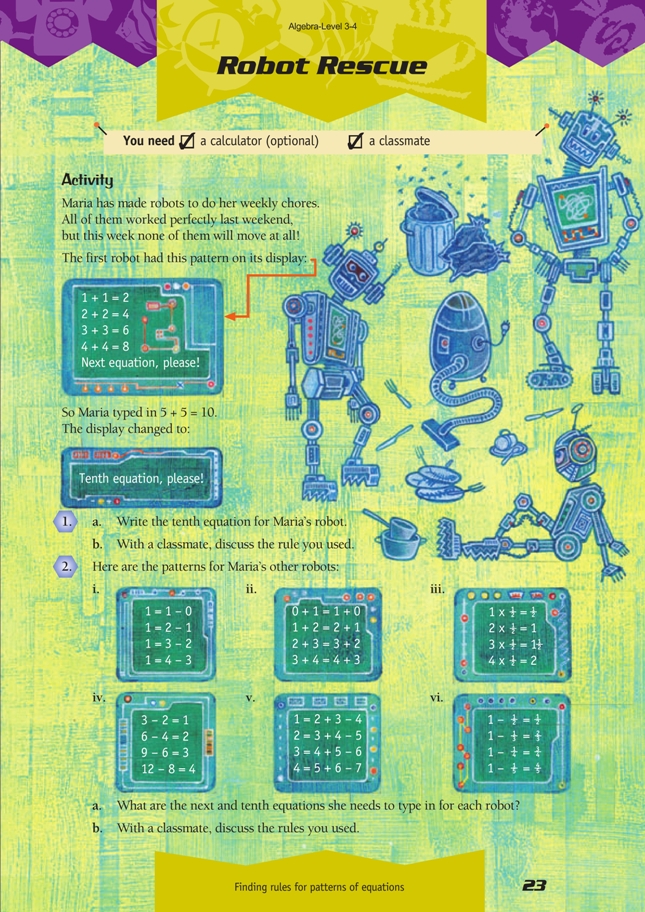This is a level 3 algebra strand activity from the Figure It Out series.
A PDF of the student activity is included.
Click on the image to enlarge it. Click again to close. Download PDF (411 KB)
solve sets of equations
calculator (optional)
classmate
The strategies that the students use to continue equation patterns will give a strong indication of their ability to describe relationships. For example, those students who use lower level strategies will continue the patterns using recursive thinking until they find the required equation. In Maria’s example, this would involve the following working:
1 + 1 = 2
2 + 2 = 4
3 + 3 = 6
4 + 4 = 8
5 + 5 = 10
...
9 + 9 = 18
10 + 10 = 20
A more powerful strategy is to look for relationships between the numbers in each equation in a pattern. In Maria’s case, the relationship might be expressed in words, such as, “Take the first number, add it to itself, and the answer is double the first number”. This could be expressed symbolically as n + n = 2n, where n is the first number. The first number in each successive equation increases by 1, so in the tenth
equation, n = 10. This strategy is more efficient than writing the whole sequence.
When the students are expressing equation sets algebraically, they need to choose the number represented by n carefully. For example, in question 2a i, choosing the number after the equals sign as n makes expressing the rule simple:
1 = 1 – 0
1 = 2 – 1
1 = 3 – 2
1 = 4 – 3
...
1 = n – (n – 1). Choose any number and take away one less than it.
The answer is always 1.
An important idea for the students to grasp is that the equals sign is a statement of symmetrical balance. Number balances such as those used in Algebra, Figure It Out, Level 3, page 19 can help reinforce this idea. Many students believe from their previous experiences that the equals sign means “works out to be” because the unknown was always shown at the right of the equals sign, for example, 4 + 3 = , 9 x 7 = . Activities such as these equation sets help to broaden the students’ view of the equals sign.
Answers to Activity
1. a. 10 + 10 = 20
b. The first number plus itself equals double the first number: n + n = 2n.
2. a. i. next: 1 = 5 – 4
tenth: 1 = 10 – 9
ii. next: 4 + 5 = 5 + 4
tenth: 9 + 10 = 10 + 9
iii. next: 5 x 1/2 = 21/2
tenth: 10 x 1/2 = 5
iv. next: 15 – 10 = 5
tenth: 30 – 20 = 10
v. next: 5 = 6 + 7 – 8
tenth: 10 = 11 + 12 – 13
vi. next: 1 – 1/6 = 5/6
tenth: 1 – 1/11 = 10/11
b. Answers will vary. Possible answers are:
i. Take any number and then take away one less than it. The answer is always 1.
n – (n – 1) = 1. For example, 10 – 9 = 1.
ii. Take any number. Add it to 1 more than itself. The answer is always the
same as taking the next number and adding the number to it.
n + (n + 1) = (n + 1) + n. For example, 10 + 11 = 11 + 10.
iii. A number multiplied by 1/2 gives the same answer as the number divided
by 2: n ÷ 2 = n x 1/2. For example, 10 x 1/2 = 10 ÷ 2.
iv. Any number is equal to three times the number minus two times the number.
3n – 2n = n. For example, 30 – 20 – 10.
v. Any number is equal to 1 more than itself added to 2 more than itself minus
3 more than itself: n = (n + 1) + (n + 2) – (n + 3). For example, 10 = 11 + 12 – 13.
vi. This is very cumbersome in words.
1 minus the fraction that has 1 as the numerator and the number itself as the
denominator is equal to the fraction that has 1 less than the number as the
numerator and the number itself as the denominator. (This shows how useful
using letters can be!)
